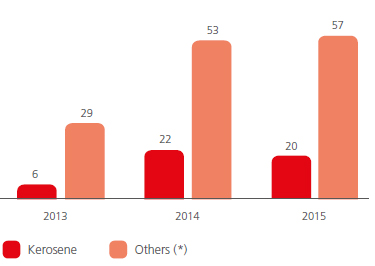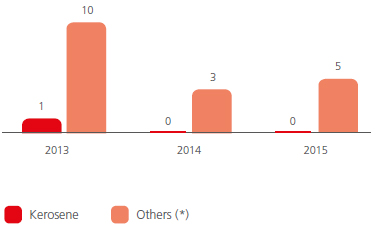Effluents and spills
Effluent management
The management of water effluents is mainly related to catchment and removal/treatment systems of civil effluents (or the like) coming from airport infrastructures and the rainwater flowing from waterproof surfaces.
Catchment and removal of domestic wastewater from all the buildings on airport grounds is ensured at Malpensa by the sewer system carrying wastewater to S. Antonino consortium treatment plant, and at Linate by the sewer system connected to Peschiera Borromeo treatment plant. The water drained into the sewers (black waters and treated storm waters) are subjected to systematic quality controls.
At both airports, the quality of wastewater falls within the limits set by current environmental legislation, as shown in tables reporting monitored parameters.
Linate - Characterisation of sewer drainage
| Parameter | Unit of measure | Average annual value | Parameters values Italian Legislative Decree 152/06 | ||
|---|---|---|---|---|---|
| 2015 | 2014 | 2013 | |||
| COD | mg/l | 47.7 | 86.0 | 151.4 | 500 |
| BOD5 | mg/l | 23.1 | 27.0 | 52.5 | 250 |
| Total phosphorous | mg/l | 1.3 | 1.0 | 2.7 | 10 |
Source: SEA
Malpensa - Characterisation of sewer drainage
| Parameter | Unit of measure | Average annual value | Parameter values Italian Legislative Decree152/06 | ||
|---|---|---|---|---|---|
| 2015 | 2014 | 2013 | |||
| COD | mg/l | 203.5 | 254.4 | 246.7 | 500 |
| BOD5 | mg/l | 87.4 | 73.1 | 86.4 | 250 |
| Total phosphorous | mg/l | 3.5 | 3.3 | 3.8 | 10 |
Source: SEA
The following graph shows wastewater drained into the sewer system, while the remaining quantities are drained on surface by dispersion.
Water drainage into sewer (m3)

Note: Linate data do not include SEA Energia drainage values. With reference to the Linate airport in 2013, the drainage was equal to the total withdrawals from the wells. Since 2014 the drainage was estimated to be equal to the total withdrawals from the wells, net of the estimated losses of the aqueduct network.
Source: SEA
De-icing treatment of aircraft during the winter, when requested by airlines, is carried out in dedicated stands equipped with a collection system for any effluents from the activity, which are treated as special waste.
Disposed de-icing liquid (tons)
| 2015 | 2014 | 2013 | |
|---|---|---|---|
| Malpensa | - | 15 | 44 |
| Linate | 91 | 45 | 68 |
Source: SEA
Storm waters from airport surfaces flow into surface water bodies (Linate) or in the superficial part of the subsoil (Malpensa). For those areas subject to regional regulations, the first rain water is separated beforehand (treated with oil removal systems and conveyed to public sewer system).
Prior to final delivery, rainwater undergoes periodic quality checks on parameters highlighted in tables, with qualitative characteristics that are broadly in line with environmental standards of reference.
Linate - Characterisation of surface water drainage
| Parameter | Unit of measure | Average annual value | Parameter values Italian Legislative Decree 152/06 | ||
|---|---|---|---|---|---|
| 2015 | 2014 | 2013 | |||
| Chromium VI | mg/l | 0.01 | 0.005 | 0.0 | 0.2 |
| Copper | mg/l | 0.02 | 0.006 | 0.0 | 0.1 |
| Lead | mg/l | 0.01 | 0.005 | 0.0 | 0.2 |
| Zinc | mg/l | 0.10 | 0.05 | 0.2 | 0.5 |
| Total hydrocarbons | mg/l | 0.29 | 0.2 | 0.5 | 5.0 |
Source: SEA
Malpensa - Characterisation of surface water drainage
| Parameter | Unit of measure | Average annual value | Parameter values Italian Legislative Decree 152/06 | ||
|---|---|---|---|---|---|
| 2015 | 2014 | 2013 | |||
| Ph | PH unit | 7.3 | 7.3 | 7.4 | 8.0 |
| COD | mg/l | 14.4 | 10 | 16.3 | 100.0 |
| BOD5 | mg/l | 10.3 | 10 | 6.8 | 20.0 |
| Total suspended solids | mg/l | 6.4 | 5 | 6.5 | 25.0 |
| Total phosphorous | mg/l | 0.1 | 0.1 | 0.5 | 2.0 |
| Lead | mg/l | 0.01 | 0.01 | 0.0 | 0.1 |
| Chromium VI | mg/l | 0.01 | 0.01 | 0.0 | 0.2 |
| Copper | mg/l | 0.01 | 0.01 | 0.0 | 0.1 |
| Total hydrocarbons | mg/l | 0.1 | 0.1 | 0.5 | 5.0 |
| Zinc | mg/l | 0.05 | 0.01 | 0.0 | 0.5 |
| Total surfactants | mg/l | 0.2 | 0.2 | 0.3 | 0.5 |
Source: SEA
There are currently no water reuse systems at airports.
Along with other important European players, SEA Group is delving into many aspects related to water saving systems and the possibility of re-using rainwater, with a view to reducing groundwater extraction and rationalizing water consumption.
Spill management
We strive to act with care and ensure proper management of potential spills. In the event of accidental spills of fuel or oil in operating areas, runways and aprons, fluids are intercepted before they enter rainwater drainage system.
Airports have a specific procedure applicable to terminal movement areas in compliance with environmental protection standards.
In these cases, our Airport Maintenance and Environmental Operations Management functions are activated in order to coordinate cleaning and reclamation measures in the concerned areas, and the restoration of conditions of compliance and safety, after Fire Brigade lays an adequate number of oil-absorbing panels to contain the area affected by spill. At each airport, waste generated in cleaning operation is transferred to appropriate facilities of airport sanitation islands, as required by company procedures, in compliance with environmental protection and occupational safety and sanitation standards applied at both our airports.
Spills taken into consideration are those deemed to be significant, that is, those that have affected an area equal to or greater than 20 m2.
Malpensa - Major spillages (No.)

(*) Spills of hydraulic oil from an aircraft, hydraulic oil from operating vehicles and spills of diesel/gasoline from operating vehicles.
Source: SEA
Linate - Major spillages (No.)

(*) Spills of hydraulic oil from an aircraft, hydraulic oil from operating vehicles and spills of diesel/gasoline from operating vehicles.
Source: SEA
Malpensa airport has recorded a slight improvement for kerosene spills, while there was a slight increase in hydraulic oil spills caused by operational vehicle faults, mainly due to old age of vehicles used by handlers working under aircraft. Specific Working Groups for event mitigation were activated, and some handlers are carrying out a fleet modernisation.